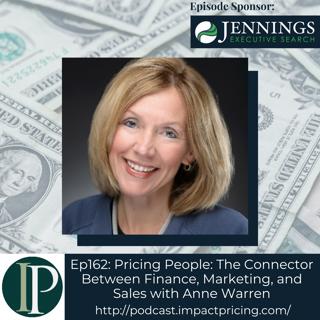
Pricing People: The Connector Between Finance, Marketing, and Sales with Anne Warren
Anne Warren is the Senior Director of Global Pricing at Shure – an appliances, electrical, and electronics manufacturing company that produces best-in-class audio products with high-quality performance, reliability, and value. Anne started out as an accountant and an auditor. She's been leading pricing teams for about 20 years now. In this episode, Anne shares the power behind pricing people working with sales, finance, and marketing departments in order to better market a product in a competitive market. Why you have to check out today’s podcast: Discover why pricing people serve as the connector between the finance, marketing, and sales departments of a company; Understand why rapport with those internally involved in the business is essential in marketing a product; and Know how you can establish an effective rapport with other teams aside from yours through tips from an expert “Establishing the rapport, especially with the sales and leadership team, treating your sales leaders as business partners, and make sure they know – not that you're going to necessarily agree all the time – but that they have a voice and you are going to be collaborative with them.” – Anne Warren Topics Covered: 01:40 – From being an auditor to becoming a pricing person 03:20 – Pricing people being that connector between finance, marketing, and sales 05:41 – Learning about the need to be collaborative across these departments 06:38 – How Anne works with salespeople 08:42 – The context of Anne’s script when talking to customers 10:24 – Mark’s four points with regards to writing a price increase letter 11:09 – Why raising prices shouldn’t be an intimidating initiative 13:33 – How Anna does what needs to be done while working with finance and salespersons 14:59 – Marketing people know the value of their products better than pricing people 16:23 – Seeing the collaboration in different perspectives 18:08 – Having a value statement and being able to share it 19:35 – Product managers being too far removed from value 22:18 – Anne’s piece of pricing advice for today’s listeners Key Takeaways: “It’s important to take yourself outside of your role as a pricing person or as a finance person, and really think and learn, most importantly, about the other person's goals.” – Anne Warren “It's the pricing person's role to be that connector between finance, marketing, and sales.” – Anne Warren “Being transparent. Don't try to hide. Don't try to be mysterious. Be honest with your customers. I think that will definitely go a long way. And the letters that go out are fine, but I think a live discussion between a salesperson and their customer works wonders as well.” – Anne Warren “You want them to feel good about their product. You want to help call out that value proposition maybe in more less technical terms, if it's a technical product, and more about the value prop to the end user customer or B2B customer. What's in it for them and how can we monetize that? Help bridge the gap to get the salespeople confident.” – Anne Warren “Never underestimate the power of a confident salesperson.” – Anne Warren “If you're starting a new job as a pricing professional, I feel strongly you also need a good relationship with finance, but the sales teams in particular, if you have good rapport with them, you're going to make huge inroads and be very successful as a pricing professional.” – Anne Warren “Try to be as natural as you can be, as open and transparent. What is your role? Your role is to be a partner. That is the first message you should deliver to establish that rapport and mean it. Be that partner and establish that early on in the relationship. That's the best thing you can do that will give you firepower for initiatives that you want to perform later on.” – Anne Warren People / Resources Mentioned: Shure Incorporated: http://www.shure.com Ameritech / AT&T: https://www.att.com/ Connect with Anne Warren: LinkedIn: https://www.linkedin.com/in/anne-warren-214ab745/ Email:annewarren720@gmail.com Connect with Mark Stiving: LinkedIn: https://www.linkedin.com/in/stiving/ Email: mark@impactpricing.com
28 Feb 202226min

Blogcast #42: Willingness to Accept
This is an Impact Pricing Blog published on January 12, 2022, turned into an audio podcast so you can listen on the go. Read Full Article Here: https://impactpricing.com/blog/willingness-to-accept/ If you have any feedback, definitely send it. You can reach us at mark@impactpricing.com. Now, go make an impact. Connect with Mark Stiving: Email: mark@impactpricing.com LinkedIn: https://www.linkedin.com/in/stiving/
25 Feb 20222min
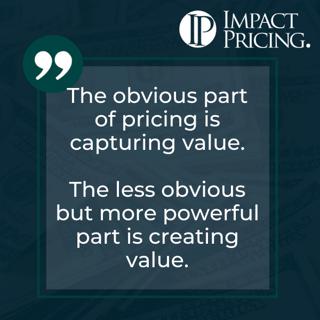
Memecast #47: Creating Value
When we think about pricing, typically we have a product in hand and we say, how much does our customer value this? How much are they willing to pay? Now, we're going to put a price tag on that. And that's really important. We want to be able to do that well. And that's typically what we think of when we think of pricing. But if we take a step or two backwards in the business process, the fact that we as pricing people understand value, we understand how customers perceive value. Imagine if the product managers or developers or whoever's defining the products that we're going to build, imagine if they understood this concept of value the way we understand the concept of value. Because then they could be creating products that our customers actually value. “The less obvious but more powerful part of pricing is creating value.” - Mark Stiving If we think about the products or the features that we create and how they drive value, we'll end up creating better products, products that our customers love more, products that we can charge more for. So, yes, product management, the creating value part, is huge. We hope you enjoyed this memecast. If you have any questions or feedback, please email me mark@impactpricing.com. Now, go make an impact. Connect with Mark Stiving: Email: mark@impactpricing.com LinkedIn: https://www.linkedin.com/in/stiving/
23 Feb 20221min
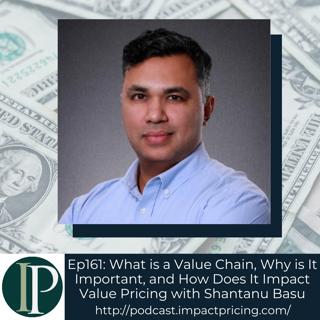
What is a Value Chain, Why is It Important, and How Does It Impact Value Pricing with Shantanu Basu
Shantanu Basu is currently the Senior Director of Go-To Marketing Strategy and Operations at Tanium. He was Director of Strategy and Operations at Intel for a long time, and he's part of an organization called RevGenius. Shantanu got his MBA from the University of Michigan. In this episode, Shantanu discusses value chain alignment alongside the importance of knowing what your value is and understanding what your customers think what your value is. Why you have to check out today’s podcast: Discover why knowing your company’s value and understanding how your customer sees value in you when doing pricing; Understand the importance of doing things one at a time, especially when communicating about the company’s value chain; and Find out why it’s necessary for you to be able to ask the right value chain alignment questions “When you think of yourself as a pricing professional, you're doing your pricing jobs so to speak, don't limit yourself to what somebody else might consider the definition of your job. As a pricing professional, you should be able to ask questions and articulate – if you ask the right questions; articulate the value of your product across the entire value chain.” – Shantanu Basu Topics Covered: 01:47 – How Shantanu got into pricing alongside the discussion around capturing and communicating value 04:20 – Knowing your value vs. understanding what your customers think your value is 10:34 – How he communicates with people to help them understand how the value chain inside that company looks like 13:57 – The difference between being right and being effective in doing pricing 17:58 – How to align product positioning with packaging 22:34 – Discussion around the good, better, best framework 26:35 – Briefly talking platform pricing and how it intersects with good, better, best 30:49 – Shantanu’s piece of pricing advice for today’s listeners Key Takeaways: “Do you understand how value is created for your product, your business, your industry? Do you know how to communicate and then, hence, capture that value? It starts and ends with value. As long as you can connect those different points along the value chain, you perhaps have something to go to market with.” – Shantanu Basu “Change comes from understanding. If I don't understand how my product positioning team and/or my sales team thinks our value is, I don't know how to influence that change, assuming I am right in understanding what the customer said.” – Shantanu Basu “Every time there is a shift to be made from our steady state, you start to ask these questions and go try to reach as far back into the value chain as you can without pissing off too many people and slowing down business. It becomes an art rather than a science.” – Shantanu Basu “Change management is not about right and wrong or numbers or the customer. It's about people and the emotions and maneuvering the informal dynamics of an organization, which I would like to think it only comes with experience.” – Shantanu Basu “Pricing isn't rocket science. Influencing change via pricing and influencing the right behavior – whether of your customer, your sales rep, your CEO, or your customer success person – is where the art comes in.” – Shantanu Basu “You don't have to be an expert in every piece of the value chain. That's not your job. There are people who will always do better than you. But stretch all the way down the value chain and all the way up the value chain and feel free and empowered to ask questions at each point so that you understand the entire value chain. Because when it comes down to this “simple piece of pricing”, your understanding across the value chain is what's going to probably provide the best results, not just coming up with a number and not just coming up with X.” – Shantanu Basu People / Resources Mentioned: Tanium: https://www.tanium.com/ Stephanie Hallford: https://www.linkedin.com/in/stephanie-hallford-ba90732 Connect with Shantanu Basu: LinkedIn: https://www.linkedin.com/in/basushantanu/ Email: basu@gmail.com Connect with Mark Stiving: LinkedIn: https://www.linkedin.com/in/stiving/ Email: mark@impactpricing.com
21 Feb 202233min
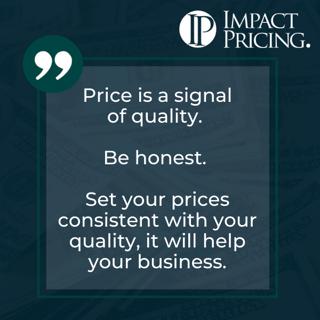
Memecast #46: Signal of Quality
We all know that price is a signal of quality, but what ends up happening is, over time people learn what the true quality is, and they realize if the prices match that true quality or not. If we're able to price relative to our true quality, then all is right with our customers in their minds and they're not going to change their purchase decisions. They're more likely to stick with us. Now, what happens if we deliver a ton of quality and we charge a low price? Well, first off, maybe a lot of people aren't going to find out because they're using our price as an indicator of quality. And they say, oh, that's way too inexpensive. It's not a product that would fit my needs. So, they never learned that yours is great. Once of course, someone buys in and they start using it, then sure, they say, hey, this is a fantastic deal. Maybe they talk about it, word of mouth. The question becomes, can you get people to buy it because it's such a low price. On the other hand, let's say you charge a really high price for something. And then they take it home, they realize, oh, this really isn't worth that price. Now we get negative word of mouth. People tend not to buy. They're certainly not going to buy again. “Price is a signal of quality.” - Mark Stiving It's so much easier if we could figure out what our quality levels really are and set our prices consistent with what those quality levels are. It's a great way to build a long-term sustainable business. We hope you enjoyed this memecast. If you have any questions or feedback, please email me mark@impactpricing.com. Now go make an impact. Connect with Mark Stiving: Email: mark@impactpricing.com LinkedIn: https://www.linkedin.com/in/stiving/
18 Feb 20222min
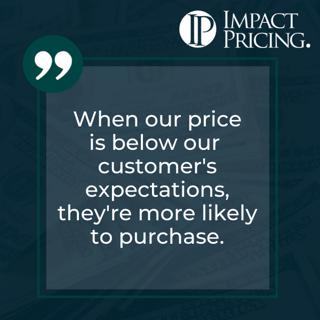
Memecast #45: Reference Prices
There's a concept in economics, behavioral economics, called reference prices. And reference prices really say our customers have some expectation about what they think they're going to pay. And if our price is below that expectation, they get a good feeling they're getting a good deal. And the fact that they're getting a good deal provides them an incentive or the good feelings that say I'm actually going to buy. Richard Thaler broke this up into two different types of utility. There's transaction utility and there's functional utility. The functional utility is the utility that someone gets from our product. It's the reason they're buying it. But transactional utility is the feelings you get when you're going to buy something. And if you walk into a store expecting to pay $20, and you find it on sale for 15, you're thinking, Hey, that's a really neat deal, I'm going to buy that. Or you're more likely to buy it. "We should be paying attention to our customer's expectations." - Mark Stiving If we have a way to control expectations, to raise expectations before they actually buy, and then we give them a price that's below those expectations, it makes it more likely they'll pull out their wallet and buy from us. We hope you enjoyed this podcast. If you see have any questions or feedback please email me mark@impactpricing.com. Now go make an impact. Connect with Mark Stiving: Email: mark@impactpricing.com LinkedIn
16 Feb 20221min
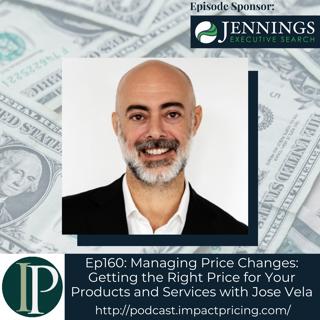
Managing Price Changes: Getting the Right Price for Your Products and Services with José Vela
José Vela is the Director of Pricing at Spandex Barcelona, known as one of the leading suppliers of graphics and digital materials worldwide. He is a strategic and business savvy leader who empowers business development and profitability improvements for global businesses, with an expertise in directing international trade, manufacturing, and services operations. José moved into pricing after having a General Manager's role. In this episode, José talks about the importance of getting the right price in selling your services as he relates it to the change and value you’re providing to your customers. Why you have to check out today’s podcast: Understand why it’s a must for you to be able to price your products and services right in relation to winning more deals even at a high price; Discover how experience adds up to a pricing person’s credibility, therefore, resulting to high rates of success in sales; and Find out how necessary it is for you to think like your customers in order to provide the best value in the market. “You need to be able to analyze your own data in order to identify where your margin, your profitability is, what are the leakages, and then you need to act on them.” – José Vela Topics Covered: 01:49 – Getting into the world of pricing: Winning more deals through knowing the right price 05:52 – General managers providing more credibility to the table and being able to demonstrate success through experience 09:00 – The value being present on the extended product; thinking like the customers 13:15 – Building the analytics capability to prove the impact of pricing decisions 16:49 – Why list prices matter so much 18:00 – How to effectively manage list prices in relation to the benchmarks 23:07 – José’s piece of pricing advice for today’s listeners Key Takeaways: “Most of the time, sales people – they are driven when we are talking about pricing. They are driven by fear. They are afraid of losing the deal, losing the customer if they base off them. And if you are able to provide them data, reliable information, they feel more confident and they know that they can offer a right price and they know it right because other similar customers are paying.” – José Vela “Country managers are really competitive. We are competitive animals and we know to overperform. We want to overachieve. And if we see that some of our colleagues are succeeding, we want to know what's the deal, what's going on there, because we want to replicate this, these tools, those processes, whatever they are doing to succeed. We want to make sure that we are doing the best in order to succeed too. So, if you are able to find early adopters that are able to show and demonstrate quick wins, this also helps a lot.” – José Vela “The impact of pricing is, how do we manage the list prices? And how do we manage the discounts that we are giving to our customer? The main driver for margin value is – without any doubt – how do you manage your pricing? And if you are not able to organically growth a lot for whatever the reason, how you manage your list prices is the biggest driver to increase your revenue.” – José Vela “In general, it's not just pricing the prices. It’s making the right price. Pricing goes in two directions. It’s not only about rising prices. Sometimes, you decrease.” – José Vela “Most of the pricing initiatives, the critical piece is never the technology, or at least from my point of view, because there are different ways to do stuff, different platforms, but how do you manage the change? How do you train the people? How do you make them feel comfortable and embrace the change? That's the most difficult part. Ever. Always.” – José Vela People / Resources Mentioned: Spandex: https://www.spandex.com/ Toyota: http://www.toyota.com/ Connect with José Vela: LinkedIn: https://www.linkedin.com/in/jvela/ Email: jjvelar@gmail.com Connect with Mark Stiving: LinkedIn: https://www.linkedin.com/in/stiving/ Email: mark@impactpricing.com
14 Feb 202226min

Blogcast #41: Opportunity Costs and Pricing
This is an Impact Pricing Blog published on January 5, 2021, turned into an audio podcast so you can listen on the go. Read Full Article Here: https://impactpricing.com/blog/opportunity-costs-and-pricing/ If you have any feedback, definitely send it. You can reach us at mark@impactpricing.com. Now, go make an impact. Connect with Mark Stiving: Email: mark@impactpricing.com LinkedIn
11 Feb 20223min






















